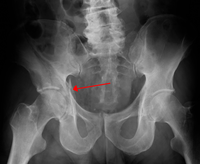
Photo from wikipedia
Background Infra-acetabular screws have been described to increase the fixation strength of acetabular fractures with separation of the columns. Previous studies were based on the simulation of the anterior column… Click to show full abstract
Background Infra-acetabular screws have been described to increase the fixation strength of acetabular fractures with separation of the columns. Previous studies were based on the simulation of the anterior column fractures without modelling the biomechanical effect of the screw in the posterior column fractures. The purpose of this study was to compare the stability of different internal fixation models of posterior column fracture and to provide a theoretical basis for the clinical application of infra-acetabular screws. Methods Five internal fixation models of acetabular posterior column fracture were simulated using five implants, including one reconstruction plate (PCP model), one posterior column screw (PCS model), one infra-acetabular screw (PIS model), one infra-acetabular screw and one reconstruction plate (PIS + PCP model), and one infra-acetabular screw and one posterior column screw (PIS + PCS model). After meshing, material parameter, and boundary condition settings, a vertical downward load of 500 N was applied on the surface of the sacrum. To evaluate the biomechanical properties, the stress distribution and von Mises peak stress were recorded and analyzed, and the displacement distributions of the upper and lower fracture surfaces were compared. Results In model PCP, the maximum stress of the plate is 71.952 MPa; in model PCS, the maximum stress of the screw is 52.740 MPa; in model PIS, the maximum stress of the screw is 68.985 MPa; in model PIS + PCP, the maximum stress of the plate is 64.695 MPa and the maximum stress of the screw is 39.679 MPa; and in model PIS + PCS, the maximum stress of the posterior column screw is 48.197 MPa and the maximum stress of the infra-acetabular screw is 65.201 MPa. The maximum stresses of implants are all located on the fracture surfaces. The average displacement differences of the upper and lower fracture surfaces are compared as follows: model PIS + PCS (0.03503 mm) < model PIS + PCP (0.08205 mm) < model PCP (0.10096 mm) < model PCS (0.19007 mm) < model PIS (0.23546 mm). Conclusion With sufficient biomechanical stability, infra-acetabular screws can be used as a supplementary fixation for the treatment of acetabular posterior column fractures. It is recommended to fix the fracture by the combined application of the infra-acetabular screw and posterior column screw.
Journal Title: International Orthopaedics
Year Published: 2022
Link to full text (if available)
Share on Social Media: Sign Up to like & get
recommendations!